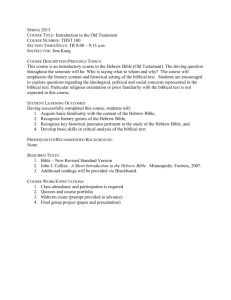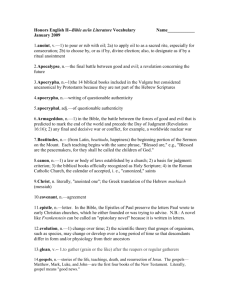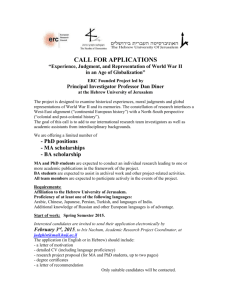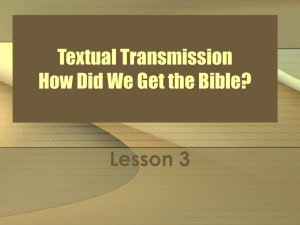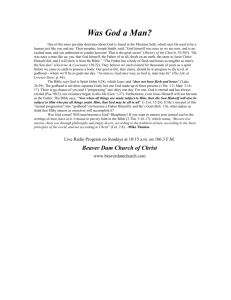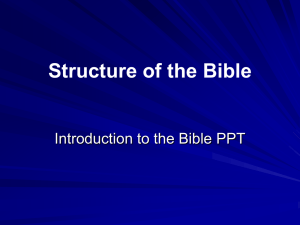Essays
advertisement
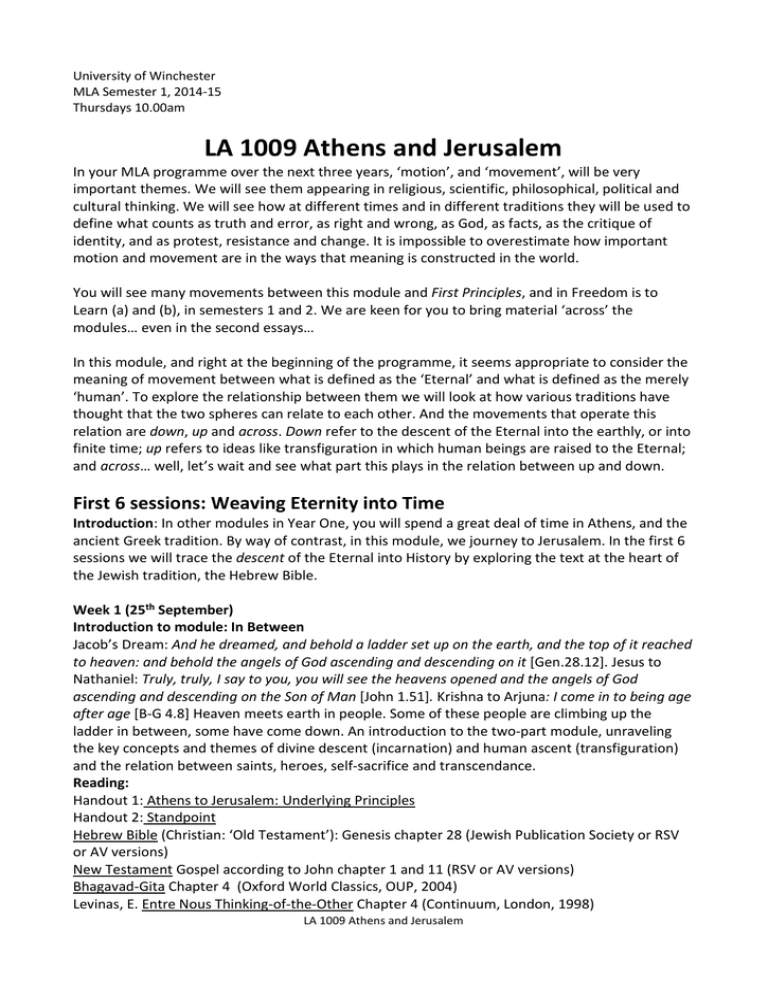
University of Winchester MLA Semester 1, 2014-15 Thursdays 10.00am LA 1009 Athens and Jerusalem In your MLA programme over the next three years, ‘motion’, and ‘movement’, will be very important themes. We will see them appearing in religious, scientific, philosophical, political and cultural thinking. We will see how at different times and in different traditions they will be used to define what counts as truth and error, as right and wrong, as God, as facts, as the critique of identity, and as protest, resistance and change. It is impossible to overestimate how important motion and movement are in the ways that meaning is constructed in the world. You will see many movements between this module and First Principles, and in Freedom is to Learn (a) and (b), in semesters 1 and 2. We are keen for you to bring material ‘across’ the modules… even in the second essays… In this module, and right at the beginning of the programme, it seems appropriate to consider the meaning of movement between what is defined as the ‘Eternal’ and what is defined as the merely ‘human’. To explore the relationship between them we will look at how various traditions have thought that the two spheres can relate to each other. And the movements that operate this relation are down, up and across. Down refer to the descent of the Eternal into the earthly, or into finite time; up refers to ideas like transfiguration in which human beings are raised to the Eternal; and across… well, let’s wait and see what part this plays in the relation between up and down. First 6 sessions: Weaving Eternity into Time Introduction: In other modules in Year One, you will spend a great deal of time in Athens, and the ancient Greek tradition. By way of contrast, in this module, we journey to Jerusalem. In the first 6 sessions we will trace the descent of the Eternal into History by exploring the text at the heart of the Jewish tradition, the Hebrew Bible. Week 1 (25th September) Introduction to module: In Between Jacob’s Dream: And he dreamed, and behold a ladder set up on the earth, and the top of it reached to heaven: and behold the angels of God ascending and descending on it [Gen.28.12]. Jesus to Nathaniel: Truly, truly, I say to you, you will see the heavens opened and the angels of God ascending and descending on the Son of Man [John 1.51]. Krishna to Arjuna: I come in to being age after age [B-G 4.8] Heaven meets earth in people. Some of these people are climbing up the ladder in between, some have come down. An introduction to the two-part module, unraveling the key concepts and themes of divine descent (incarnation) and human ascent (transfiguration) and the relation between saints, heroes, self-sacrifice and transcendance. Reading: Handout 1: Athens to Jerusalem: Underlying Principles Handout 2: Standpoint Hebrew Bible (Christian: ‘Old Testament’): Genesis chapter 28 (Jewish Publication Society or RSV or AV versions) New Testament Gospel according to John chapter 1 and 11 (RSV or AV versions) Bhagavad-Gita Chapter 4 (Oxford World Classics, OUP, 2004) Levinas, E. Entre Nous Thinking-of-the-Other Chapter 4 (Continuum, London, 1998) LA 1009 Athens and Jerusalem Weil, S. Grace and Gravity Chapters: The Cross (p79f) and Grace and Gravity (p1f) Week 2 (2nd October) Heaven and Earth Heaven meets earth in nature. We shall explore the two Creation stories in Genesis and look at the interpretive method called PARDES (the fours layer of meaning to be unearthed in the text through creative exploration). We shall learn about the Hebrew Bible. Why do Christians still call it the ‘Old Testament’? Reading: Handout: PARDES Handouts: A Variety of Creation Stories Handout: Introduction to the Bible Hebrew Bible (Christian: ‘Old Testament’): Genesis chapter 1-2 (Jewish Publication Society or RSV or AV versions) Sarah, Rabbi E. Trouble-Making Judaism Part One, chapter 1 (David Paul Books, London, 2012) – Extracts Week 3 (9th October) Unexpected resources: trans and gender in the Hebrew Bible Using an essay by Rabbi Elli Sarah, and an in-depth Biblical study of the tales of the Special One, Joseph and the female prophet, Deborah, we discover how trans and gender are treated in the Hebrew Bible. Reading: Hebrew Bible (Christian: ‘Old Testament’): Genesis chapter 37(f) and Judges chapter 4 (Jewish Publication Society or RSV or AV versions) Sarah, Rabbi E. Joseph the Beautiful Dreamer: another way of being male (unpublished essay 2014) - Extracts Sarah, Rabbi E. Deborah the Prophet and Judge: another way of being female (unpublished essay 2014) – Extracts Wilchins, R. Queer Theory, Gender Theory (Alyson Publications, 2004) – Extracts Additional reading: Adler, R. Rabbi Engendering Judaism (Beacon Press 1999) Week 4 (16th October) Putting the Eternal in a box We will explore the Jewish concept of midbar (wilderness/desert/emptiness) and mishkan (dwelling place/sanctuary) as places of encounter and meeting, using the Biblical texts and commentaries: a) The Eternal is vividly portrayed in the Hebrew Bible in series of sacred encounters b) the people create sacred spaces to ‘hold’ these encounters:, standing stones in high places, the sacred box (ark), the portable Tent of Meeting and the Temple. Reading: Hebrew Bible (Christian: ‘Old Testament’): Genesis chapter 28, Exodus chapter 3, 15, 16, 17, 19, 25, 29, 40; I Chronicles chapter 28; I Kings chapter 8 (Jewish Publication Society or RSV or AV versions) Sarah, Rabbi E. Encountering the Eternal: Beyond the Tyrannical Dictator and Towards the Elusive (unpublished essay 2014) - Extracts LA 1009 Athens and Jerusalem Week 5 (23rd October) No session Week 6 (30th October) Seeking the Eternal in the city Heaven meets earth in the Holy City. All three Abrahamic religions - Judaism, Christianity and Islam - share Jerusalem as a holy site. The city has been invaded, occupied, plundered, contested, destroyed, re-built, shared, divided… It has been called ‘the eye of the storm of the world’. Where is the Eternal to be found in all this? Reading: Hebrew Bible (AV Old Testament): Psalm 122 and commentary Handout: Blake. W Jerusalem Josephus The Fall of Jerusalem (Penguin London 2006) Burton, R. To the Holy Shrines (Penguin 2007) Handout: The Night Journey of the Prophet; the Dome of the Rock and the Al-Asqa Mosque; Via Dolorosa and the Church of the Holy Sepulchre; Two Walls – The Kotel Second six sessions: Bodies on the Line: the Self-Transfigured Introduction: In the second half of the module we will look at the ascent, as it were, of the human into the Eternal. Looking at history through biography we will view huge movements and key moments in history through the prism of the lives of a few extraordinary individuals. We will compare and contrast saints with heroes and explore the themes of self-sacrifice and selftranscendence. Week 7 (November 6th) Anti-heroes Moses, Jesus and Mary: these three foundational figures in Judaism and Christianity all transgress. We study their representations in Hebrew Bible and Christian gospels and focus on Jesus the Outsider and Jew. Reading: Hebrew Bible (Christian: ‘Old Testament’): Exodus chapter 2-4 Kierkegaard, S. Attack Upon ‘Christendom’ [on-line edition of Ed. Lowrie, W. University of Princeton Press 1946] Handout: Jesus the Jew – extracts from gospel, according to Matthew Wood, J. Jesus Post-Christianity (unpublished teaching handbook) – extracts Vermes, G. Christian Beginnings (Penguin 2003) Handout: Infancy Narratives – Mary/Miriam Week 8 (13th November) Transgressive ‘saints’ LA 1009 Athens and Jerusalem Francis Bacon and Tracey Emin: we study how the lives of two artists reveal the under-side of their societies yet are transformed (descent in to hell and ascent in to heaven): using their writings and art works). Reading: Handout: Images by Emin [www.saatchigallery.com/artist] Emin, T. My Life in a Column (Rizzoli 2011) Emin, T. Strangeland (Sceptre 2005) Sylvester, D. Interviews with Francis Bacon (T&H London 1987) Hoban, P Lucian Freud (comments on Bacon) (Icon, Amazon 2014) Week 9 (20th November) Saintly ‘transgressors’ Condemned to die, Catholic saint Jeanne d’Arc took off the ‘shift’ the church captors forced her to wear and demand her male clothes back. Burned as a witch – redeemed as a saint. We trace her journey. The Sufi Master and poet, Rumi, passionately loved his friend and Teacher, Shams. Out of this love, he developed an inclusive mysticism which broke the spiritual boundaries of his time and ours . Reading: Pernoud, R. Joan of Arc (Penguin 1964) Shaw, Bernard Saint Joan (Penguin Plays 1966) Hebrew Bible (Christian: ‘Old Testament’): Song of Songs (Jewish Publication Society or RSV or AV versions) Barks, C. and Moyne, J. The Essential Rumi (Penguin, London 1995) Barks, C. Rumi - The Book of Love (Harper One USA, 2003) Burckhardt, T. Introduction to Sufi Doctrine (World Wisdom 2008) chapters 1, 4, and 8. Further reading: Sackville-West, V. Saint Joan of Arc (Michael Joseph, London 1936) Week 10 (27th November) Heroes and Broken Men Using the diaries of the polar explorer, Shackleton, and the records of his men, we will follow the epic journey made by a small group of men, led by him, to rescue their comrades and explore what it tells us about the un-breakable heroic male identity. All his men were saved, some only then to be slaughtered in the First World War. The poems of Wilfred Owen, and Pat Barker’s Regeneration (the story of the therapist, W.H.R.Rivers, who worked with soldiers suffering from ‘shell-shock’ [PTSD]), reveal how the concept service and self sacrifice were transformed to challenge the normative male status quo of the time. Reading: Shackleton, E. Escape from the Antarctic (Penguin 1999) Worsley, F.A. Shackleton’s Boat Journey (Birlinn 2007) Knowles, O. The Poems of Wilfred Owen (Wordsworth Poetry Library 2002) Barker, P. Regeneration (Penguin 1991) Additional reading: Shackleton, E. South (Penguin 1999) Scott, R.F. Journals: Captain Scott’s Last Expedition (Oxford World Classics 2008) Stallworthy, J. Wilfred Owen (Pimlico 2013) Stallworthy, J. Anthem for Doomed Youth (Constable London 2013) Week 11 (4th December) LA 1009 Athens and Jerusalem Bodies on the Line Ana Mendieta and the boxer, Muhammad Ali: we explore how these two People of Colour used their bodies and the body in their art. Reading: Handout: Images of Ali Ali, M. The Soul of a Butterfly (Bantam 2005) Handout: Images by Mendieta Blocker, J. Where is Ana Mendieta (Duke University Press 1999) Additional reading: Hauser, T Muhammad Ali His Life and Times (Portico 2012) Bailey, D.A. at al, Shades of Black (Duke University Press 2005) Week 12 (11th December) The collision of heaven and earth: a traumatic crash or a love-match? We will overview the module and trace the connections between self-sacrifice/self-loss and divine revelation; between human despair and transfiguration. We will ask: what is the place of the holy and heroic in our lives today? Essays Two essays; 50% each; 1750 words each. 3500 words in total Essay One: due Thursday 6th Nov, to Catherine by 3.30 in the office Using materials from weeks 1-6, describe ideas of the descent of the Eternal. Essay Two: due week 12, Thursday 11th Dec, 3.30 to Catherine in the office. Choose a title from one of the following: What is a transgressive saint? What is the relation between trangressive saints and anti-heroes? What do you understand by ascent and descent of the Eternal? Explore the idea of sacred journey with reference to any two traditions. LA 1009 Athens and Jerusalem
